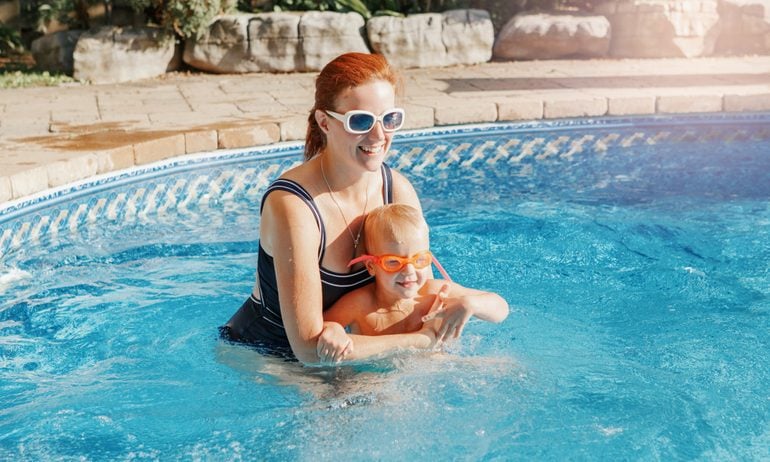5 Ways to Pay For a Pool in 2025

Many, or all, of the products featured on this page are from our advertising partners who compensate us when you take certain actions on our website or click to take an action on their website. However, this does not influence our evaluations. Our opinions are our own. Here is a list of our partners and here's how we make money.
5 inground pool financing options
1. Home equity loans
Pros and cons of financing an inground pool with a home equity loan
Pros
Fixed payments help you budget.
Often lower credit and income requirements than a personal loan.
Interest is tax deductible.
Cons
Your home is collateral for the loan.
Underwriting and appraisal may delay pool installation.
HELOC & Home Equity Loans from our partners

on Figure

640
$400,000

on New American Funding

580
$750,000

on Upstart Mortgage LLC

600
$250,000
2. Home equity lines of credit
Pros and cons of financing an inground pool with a HELOC
Pros
Borrow-as-you-need structure leaves room for add-on expenses.
Low rates and long repayment terms keep monthly payments low.
Often lower credit and income requirements than a personal loan.
Interest is tax deductible.
Cons
Variable rates mean interest costs may increase during the loan’s lifetime.
Fluctuating payments may make budgeting difficult.
Underwriting and appraisal may delay pool installation.
Your home is collateral for the loan.
3. Personal loans
Pros and cons of financing an inground pool with a personal loan
Pros
No collateral required.
Funding is fast.
Fixed payments help you budget.
Cons
Rates are likely higher than home equity financing.
Can’t be used for pools that cost over $100,000.
Short repayment terms may require large monthly payments.
4. Cash-out refinancing
Pros and cons of cash-out refinancing for an inground pool
Pros
A potentially lower mortgage rate.
Often lower credit and income requirements than a personal loan.
Interest on the cashed-out amount is tax deductible.
Cons
Your home is collateral for the loan.
Underwriting and appraisal may delay pool installation.
Closing costs are deducted from the loan proceeds.
5. Contractor financing
Pros and cons of using contractor financing for an inground pool
Pros
Funding is fast.
No collateral.
High loan amounts can pay for expensive pools.
Long repayment terms keep monthly payments low.
Cons
Rates may be higher than home equity options.
Not all contractors offer financing.
Interest is not tax deductible.
Steps to finance an inground pool
- Determine the pool’s cost. Get quotes from contractors and decide how much you’ll need to borrow. Personal and home equity loans come in a lump sum, so you will need a firm estimate to apply for the correct amount.
- Compare financing options. Once you have a solid cost estimate, compare loan options up to that amount. For example, if the pool will cost more than you can borrow in equity, then a personal loan may be a better option.
- Compare rates. After you’ve chosen the financing option with the right loan amount and repayment structure, compare lenders to find the lowest rate. Many personal loan lenders will let you pre-qualify online to see prospective rates and monthly payments.
- Make a repayment plan. Calculate your monthly pool loan payments and see if they fit in your budget. Plan to pay on time each month over the entire loan term.
- Apply. Once you’ve chosen a lender, submit an application. This step will usually trigger a hard credit pull, which will cause your credit score to dip temporarily.
How much do inground pools cost?
Ongoing costs to consider
Article sources
- 1. Consumer Financial Protection Bureau. What Is a Debt Relief Program and How Do I Know if I Should Use One?. Accessed Jan 16, 2025.
- 2. Federal Reserve Bank of St. Louis. Finance Rate on Personal Loans at Commercial Banks, 24 Month Loan. Accessed May 23, 2025.
- 3. Consumer Financial Protection Bureau. Truth in Lending Act (TILA) examination procedures. Accessed May 2, 2025.
- 4. Experian and Oliver Wyman. Financial Inclusion and Access to Credit. Accessed Jan 23, 2025.
- 5. Internal Revenue Service. Canceled debt – Is it taxable or not?. Accessed Apr 1, 2025.
- 6. Center for Responsible Lending. Payday and Other Small Dollar Loans. Accessed May 2, 2025.
- 7. National Credit Union Administration. Credit Union and Bank Rates 2024 Q4. Accessed May 23, 2025.
- 8. Consumer Financial Protection Bureau. Consumer Use of Buy Now, Pay Later and Other Unsecured Debt. Accessed Jan 24, 2025.
- 9. Consumer Financial Protection Bureau. What is a payday loan?. Accessed May 2, 2025.
- 10. Angi.com. How Much Does It Cost to Make My Home Accessible?. Accessed Nov 12, 2024.
- 11. Consumer Financial Protection Bureau. What are the costs and fees for a payday loan?. Accessed Jun 6, 2025.
- 12. Internal Revenue Service. Home energy tax credits. Accessed Mar 6, 2024.
- 13. Center for Responsible Lending. Unsafe Harbor: The Persistent Harms of High-Cost Lending. Accessed Jun 6, 2025.
- 14. Solar Energy Industries Association. Solar Power Purchase Agreements. Accessed Mar 7, 2024.
- 8. Consumer Financial Protection Bureau. Consumer Use of Buy Now, Pay Later and Other Unsecured Debt. Accessed Jan 27, 2025.
- 16. SolarReviews.com. Homes with Solar Sell for 6.8% More [2024 Zillow Data Study]. Accessed Dec 10, 2024.
- 17. Internal Revenue Service. Retirement Topics - Plan Loans. Accessed Apr 8, 2025.
- 9. Consumer Financial Protection Bureau. What is a payday loan?. Accessed Apr 4, 2025.
- 19. The Pew Charitable Trusts. Payday Loans Cost 4 Times More in States With Few Consumer Protections. Accessed Apr 4, 2025.
- 20. Federal Reserve. Military Lending Act. Accessed Apr 4, 2025.
- 21. Internal Revenue Service. Retirement topics: Exceptions to tax on early distributions. Accessed Apr 8, 2025.
- 22. Administrative Office of the U.S. Courts. Bankruptcy Basics. Accessed Apr 8, 2025.
HELOC & Home Equity Loans from our partners

on Figure

640
$400,000

on New American Funding

580
$750,000

on Upstart Mortgage LLC

600
$250,000
More like this


